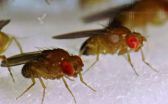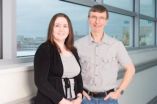(Press-News.org) Boys are at greater risk for delayed language development than girls, according to a new study using data from the Norwegian Mother and Child Cohort Study. The researchers also found that reading and writing difficulties in the family gave an increased risk.
"We show for the first time that reading and writing difficulties in the family can be the main reason why a child has a speech delay that first begins between three to five years of age," says Eivind Ystrøm, senior researcher at the Norwegian Institute of Public Health.
Ystrøm was supervisor of Imac Maria Zambrana, a former PhD student at the Norwegian Institute of Public Health who conducted the research in this study as part of her doctoral research.
The researchers used data from questionnaires completed by the mothers who are participating in the Norwegian Mother and Child Cohort Study (MoBa). The study included more than 10,000 children from week 17 of pregnancy up to five years of age.
"MoBa is a large study with a normal cross-section of the population. It gives us a unique opportunity to examine changes over time, the scope and any risk factors for delayed language development," says Ystrøm.
Mostly boys
The researchers classified the language difficulties at three and five years of age in three groups: persistent delayed language development (present at both times), transient delayed language development (only present at three years) and delayed language development first identified at five years old.
Boys are in the majority for the groups with persistent and transient language difficulties. Ystrøm explains that boys are biologically at greater risk for developmental disorders in utero than girls. British scientists have measured the male sex hormone (testosterone) in amniotic fluid and they found that the levels were related to the development of both autism and language disorders. Ystrøm points out that boys are generally a little later in language development than girls, but that most catch up during the first year. Therefore, many boys could be at risk of persistent language impairment and increasingly have transient language difficulties that disappear before school age.
The researchers found that gender was irrelevant for the third group who have language difficulties that begin sometime between three and five years of age.
Hereditary factors
We have good knowledge about normal language development in children. Many genes are important for language development and research suggests that different genes are involved in different types of language difficulty.
"Reading and writing difficulties in the family are the predominant risk factors for late-onset language difficulties. We see no language problems when the child is between 18 months and three years old. They are latent" says Ystrøm.
The researchers believe that both specific genes and factors in the child's external environment can lead to delays in language development at three to five years of age.
What can we do?
Ystrøm believes that children with delayed language development must be identified as early as possible. Parents, health care workers and child care staff should be aware of the language development of children and encourage an enabling language environment, in some cases with specially adapted measures. In particular, they must be aware of children who have sustained disabilities, or who have had normal language development up to three years and then unexpectedly began to have difficulties.
"Professionals and caregivers must be vigilant. It is difficult to detect language difficulties when language becomes more complex in older children. They must be trained so that they are confident in how to spot language difficulties and how to encourage a child's language. We need more research into the needs of children with different trajectories", says Ystrøm.
Parents who are concerned about their child's language development should consult their doctor. They should also raise the issue at the regular check-ups at the health clinic when the child is between two and four years old.
"The checks must take place at the appropriate time. It is important that they are not delayed or not implemented at all," says Ystrøm.
A few years ago, a survey by the Health and Welfare Department in Oslo showed that few of the health centres in Oslo met the required 14 consultations for each child from birth to school stipulated by the Norwegian Directorate of Health.
Further research
In addition to researchers at the Norwegian Institute of Public Health, researchers at the University of Oslo and the University of Melbourne in Australia participated in this study. The work is funded by the Extra Foundation for Health and Rehabilitation.
"We hope to continue this research and specifically look at the relationship between gender and language. We need more research into the needs of children with various types of language delay", says Eivind Ystrøm.
INFORMATION:
Reference
Zambrana, IM, Pons, F., Eadie, P. and Ystrom, E. (2013), Trajectories of language delay from age 3 to 5: persistence, recovery and late onset. International Journal of Language & Communication, doi: 10.1111/1460-6984.12073. [Epub ahead of print]
Gender and genes play an important role in delayed language development
2014-02-18
ELSE PRESS RELEASES FROM THIS DATE:
Researchers identify new way to control stone fruit disease
2014-02-18
Researchers at the University of Kent and East Malling Research have identified a new way of controlling a fungal disease that can have a devastating impact on the UK's valuable cherry and plum crops.
Brown rot disease – caused by the agent Monilinia laxa – attacks stone fruit as well as causing blossom wilt and twig canker. Traditionally, this has been controlled through the use of fungicide treatments, but in some cases these are now becoming ineffective.
Now researchers from the two organisations have identified a new strategy for controlling the disease, using biological ...
In search of lost genes
2014-02-18
How do new genes arise? Current research shows that so-called "orphan genes" may appear as if by magic as a result of mutations in segments of DNA that previously had no function. Orphan genes were first discovered in the fruit fly but are found in all organisms, including man. Strikingly, up to 30 per cent of the total number of genes in an organism may be orphans and these genes may rapidly acquire functions. Scientists from the Institute of Population Genetics of the University of Veterinary Medicine, Vienna (Vetmeduni) have now investigated the fate of orphan genes. ...
HIV drug used to reverse effects of virus that causes cervical cancer
2014-02-18
A commonly-used HIV drug has been shown to kill-off the human papilloma virus (HPV) that leads to cervical cancer in a world-first clinical trial led by The University of Manchester with Kenyatta National Hospital (KNH) in Nairobi.
Drs Ian and Lynne Hampson, from the University's Institute of Cancer Sciences and Dr Innocent Orora Maranga, Consultant in Obstetrics and Gynaecology at KNH in Nairobi examined Kenyan women diagnosed with HPV positive early stage cervical cancer who were treated with the antiviral HIV drug lopinavir in Kenya.
The study looked at 40 women ...
Leeds researchers build world's most powerful terahertz laser chip
2014-02-18
A paper in the Institution of Engineering and Technology's (IET) journal Electronics Letters reports that the Leeds team has exceeded a 1 Watt output power from a quantum cascade terahertz laser.
The new record more than doubles landmarks set by the Massachusetts Institute of Technology (MIT) and subsequently by a team from Vienna last year.
Terahertz waves, which lie in the part of the electromagnetic spectrum between infrared and microwaves, can penetrate materials that block visible light and have a wide range of possible uses including chemical analysis, security ...
The conditions for a society to become a democracy are analyzed
2014-02-18
This news release is available in Spanish. In view of the changes that have taken place in Europe,JuleGoikoetxea, a lecturer at the UPV/EHU's Faculty of Social Sciences and Communication, has been conducting research into "the conditions needed for a people to become a democracy or sustain its democratisation process over time."The study has been published in the specialised journal Nationalities Papers.
According to Goikoetxea, nation is not synonymous with demos: "The nation is the will, socially and historically articulated, that a group has in order to be a political ...
Researchers shed new light on the genetic history of the European beaver
2014-02-18
An international team of scientists has used detailed analysis of ancient and modern DNA to show that the distribution and lack of genetic diversity among modern European beavers is due largely to human hunting.
The research, which was led by University of York researcher Professor Michi Hofreiter, provides important new insights into the genetic history of the Eurasian beaver Castor fiber. Crucially, it shows the European beaver has been strongly affected by expanding human populations for many thousands of years.
The researchers say that centuries of hunting, rather ...
Surprising survey: Most small businesses remain silent rather than report employee theft
2014-02-18
In a recent survey of small businesses, a University of Cincinnati criminal justice researcher has found that only 16 percent of those that have experienced theft by employees actually reported that theft to the police.
That's even though 64 percent of the small businesses surveyed reported experiencing employee theft.
These are some of the findings in a survey of small businesses that examined the incidence of employee theft, how often it was reported, the types of goods taken by employees, the types of employees most likely to commit theft, and the reasons the business ...
Einstein's conversion from a static to an expanding universe
2014-02-18
Until 1931, physicist Albert Einstein believed that the universe was static. An urban legend attributes this change of perspective to when American astronomer Edwin Hubble showed Einstein his observations of redshift in the light emitted by far away nebulae—today known as galaxies. But the reality is more complex. The change in Einstein's viewpoint, in fact, resulted from a tortuous thought process. Now, in an article published in EPJ H, Harry Nussbaumer from the Institute of Astronomy at ETH Zurich, Switzerland, explains how Einstein changed his mind following many encounters ...
Daily walk of just 3km can reduce risk of hospitalization for respiratory problems
2014-02-18
New research in Respirology shows that suffers of Chronic obstructive pulmonary disease (COPD) can reduce their risk of being hospitalized with severe attacks, by maintaining an exercise regime of walking between three to six kilometers a day.
COPD, a term which includes chronic bronchitis and emphysema, results in breathing difficulties due to long-term lung damage. Severe symptoms (eCOPD), caused by a sudden loss of lung function, can be life threatening.
543 COPD patients were recruited from five Spanish respiratory clinics and their exercise levels were calculated ...
Magnesium may protect against hip fractures
2014-02-18
Drinking water with a relatively high concentration of magnesium protects against hip fractures, according to results of a study from the Norwegian Institute of Public Health.
There are considerable variations in the quality of drinking water in Norway. The researchers studied variations in magnesium and calcium levels in drinking water between different areas, as these are assumed to have a role in the development of bone strength. They wanted to examine whether there was a correlation between magnesium and calcium concentrations in drinking water and the incidence ...



